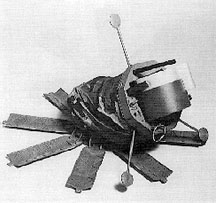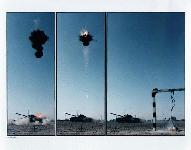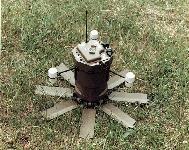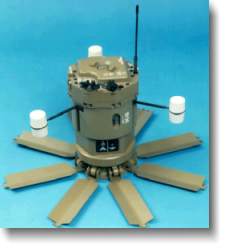 The WAM (Wide Area Munition)
is a smart, autonomous top attack anti-tank/anti-vehicle munition, designed
to defeat armored combat vehicles from a standoff distance. The WAM utilizes
acoustic and seismic sensors in its ground platform to detect, track, and classify
potential targets, and then launches an infrared detecting submunition or "sublet" over
the top of the selected target. Once the sublet detects the target, it fires an explosively
formed penetrator (EFP) to defeat the target. Target vehicles include, but are not
limited to, tanks (e.g., T-72, and T-80), breachers (e.g., KMT-4/5), and lightly armored
tracked vehicles (e.g., BMP, 152-mm SPH, and BMD). The variant currently in LRIP
is designated as the Hand Emplaced WAM (HE-WAM). It is designed to be carried
and emplaced by one person, to have a standoff lethal radius of 100 meters, 360
degrees around, and to be fully autonomous from final arming to target engagement.
The WAM, when fielded, will provide considerable precision engagement force for
the Army in the Joint Vision 2010 scenario.
Army ACAT II Program
The WAM (Wide Area Munition)
is a smart, autonomous top attack anti-tank/anti-vehicle munition, designed
to defeat armored combat vehicles from a standoff distance. The WAM utilizes
acoustic and seismic sensors in its ground platform to detect, track, and classify
potential targets, and then launches an infrared detecting submunition or "sublet" over
the top of the selected target. Once the sublet detects the target, it fires an explosively
formed penetrator (EFP) to defeat the target. Target vehicles include, but are not
limited to, tanks (e.g., T-72, and T-80), breachers (e.g., KMT-4/5), and lightly armored
tracked vehicles (e.g., BMP, 152-mm SPH, and BMD). The variant currently in LRIP
is designated as the Hand Emplaced WAM (HE-WAM). It is designed to be carried
and emplaced by one person, to have a standoff lethal radius of 100 meters, 360
degrees around, and to be fully autonomous from final arming to target engagement.
The WAM, when fielded, will provide considerable precision engagement force for
the Army in the Joint Vision 2010 scenario.
Army ACAT II Program15,259 systems
Total program cost (TY$) $800M
Average unit cost (TY$) $52.4K
Full-rate production: 3QFY98
Prime Contractor
Textron Defense Systems
DESCRIPTION: The Hornet is being developed in four sequential phases: 1) basic hand emplaced (HE-Hornet), 2) HE-Hornet product improved (HE-Hornet PIP#1) with remote control on/off/on and redeploy capabilities, 3) HE-Hornet PIP #2 with improved performance capability including the ability to engage wheeled vehicles and improved countermeasure resistance, and 4) a deep attack version (DA-Hornet, delivered by rocket, missile or fixed wing aircraft). The Hornet, common to all variants, has standoff detection and engagement capability. It attacks targets from the top at ranges of up to 100 meters and provides a mobility kill. The basic HE-Hornet engages tracked armored vehicles, and may be armed manually or by the M71 MOPMS Remote Control Unit (RCU). The HE-Hornet PIP #1 will be remotely controlled by the CIRCE RCU, and can be recovered and redeployed prior to initial arming.
Wide Area Munition consists of three major subsystems:- a communications module,
- a ground platform module, and
- a smart submunition/warhead (sublet) module.
STATUS:The Hornet program began in 1986 with a Department of the Army message. A required operational capability document was approved in 1990 that outlined a prioritized, three-phased WAM development plan: (1) deep-attack, (2) hand-emplaced, and (3) Volcano-emplaced. With the collapse of the Soviet Union and the rise in importance of early-entry operations, the priority was changed to (1) hand-emplaced, (2) hand-emplaced with two-way communication and redeployability, and (3) deep-attack.
Initially, contracts were awarded to two contractors. Alliant Techsystems' WAM prototype was based on the sense and destroy armor (SADARM) artillery warhead. Textron Defense Systems' prototype was based on their U.S. Air Force extended-range antiarmor munition proto-type. Textron won a 1990 competition and is now the sole contractor. The basic HE-Hornet's first unit equipped (FUE) date was scheduled for 4QFY98. The HE-Hornet PIP #1 is in Engineering & Manufacturing Development; its FUE is scheduled for 2QFY01. The initial operational capability quantity for HE-Hornet and HE-Hornet PIP #1 will be reached 4QFY99 and 2QFY02, respectively. Units will receive Individual and Collective Trainers. Actual live munition delivered to ammunition storage facility. The Wide Area Munition (WAM) Training Device detects, discriminates, and engages designated targets up to 100 meters away on the training battlefield. The simulation consists of placing "dummy" WAMs on the battlefied for visual realism and to input the WAM minefield information on the controlling computer system. The computer operator enters the size, shape and number of WAMs on the system based on the battlefield scenario. Whenever a tracked vehicle approaches within 100 meters of the "dummy" minefield, the vehicle sends a signal to the controlling computer system . Then the system automatically determines the probability of a "kill." The result may be a catrostophic kill, mobility kill or no kill. If there is a kill, the system alerts the vehicle of the type of kill so the vehicle operator acts accordingly. The WAM Training Device provides a realistic training environment and is an integral part of the Combat Training Center (CTC) battlefield scenario.EMPLOYMENT CONCEPT: Hornet can be used in offensive and defensive operations and in both tactical and operational level role. In the close battle, HE-Hornet will be emplaced by combat Engineers, maneuver forces under Engineer supervision, and at extended ranges by Special Operations Forces and Rangers. Hornet gauntlets, a series of randomly spaced clusters of 3-6 Hornets, will be employed along high-speed avenues of approach to disrupt and attrite the enemy. Hornet area disruption obstacles, consisting of 20 Hornets employed in an "X" pattern across a grid square, will disrupt and attrite the enemy as he moves cross country prior to the start of the direct fire battle. When employed deep, Hornet will disrupt a threat commander's operational tempo by attacking his follow-on forces, logistics and C2, by denying key terrain such as approaches to bridges/river crossing sites, and by selectively attacking high-value targets, such as Tactical Ballistic Missile (TBM) launchers.
BASIS OF ISSUE: Hornet is a Class V item.
TRAINING/PERSONNEL: USAES will provide training on the employment of Hornet. Individual and collective trainers are being procured to train operator tasks and for force-on-force training.
The WAM Required Operational Capability (ROC) document was initially prepared as a stand-alone document for the HE-WAM version, with possible future variants proposed as Pre-Planned Product Improvements (P3I). The Army rewrote the ROC as a "Family of WAM" ROC for three variants: hand-emplaced, volcano-delivered, and deep attack WAM. The ROC for the Family of WAM was approved on March 14, 1990. The Family of WAM has since been designated as an ACAT II program. Only the HE-WAM version has been developed, and was approved for LRIP in September 1996 with a full-rate production decision (MS-III) planned for June 1998. The final LFT activity took place at Yuma Proving Ground in September 1997 when six tactical WAM's with live warheads were fired at passing T-72 Soviet main battle tanks. Although three of the sublets hit their targets, only one caused substantial damage to the target. The three hit locations did not appear to conform to earlier expectations about WAM's aimpoint distribution against tank targets. Therefore, in early 1998, the hitpoints from the live firings at Yuma (and the aimpoints from the camera-equipped WAM shots at all test locations) will be compared to the data base from 1995 captive flight testing to assess the validity of previous aimpoint expectations. Of the three sublets that missed their targets, one fired on a target well beyond its capable engagement range and another fired in the wrong direction. Both of these far misses occurred during gusty wind conditions. WAM's explosively formed penetrator has demonstrated the ability to perforate substantial areas of potential threat armor targets and to cause loss of mobility or firepower after perforation. Concerns remain about the hitpoint distribution and WAM's ability to function properly under windy conditions. A manufacturing challange for the defense contractor of the warhead is that the EFP liner, which is made of Tantalum, has been known to be difficult to be machined reliably.






